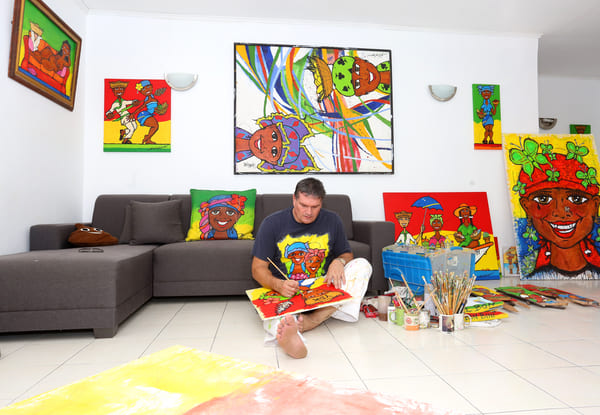 Andre Nagtegaal, born in Curaçao in 1967, is a self-taught artist with a passion for preserving and sharing his island’s culture through his whimsical and unique style of painting. Despite having no formal training in art or painting, Andre has always enjoyed doodling and experimenting with various styles. His journey as an artist began with painting landscapes of Curaçao until 2006, when he transitioned to his current distinctive style.
Andre Nagtegaal, born in Curaçao in 1967, is a self-taught artist with a passion for preserving and sharing his island’s culture through his whimsical and unique style of painting. Despite having no formal training in art or painting, Andre has always enjoyed doodling and experimenting with various styles. His journey as an artist began with painting landscapes of Curaçao until 2006, when he transitioned to his current distinctive style.
Andre calls the characters in his paintings his “Djidji’s.” These playful and expressive figures serve as a canvas to tell the rich stories and traditions of his island. His art features vibrant caricatures of smiling women and men, brimming with pride, entrepreneurial spirit, and family love. Through his work, Andre brings to life scenes such as a sister tying an elaborate lensu di kabes (head scarf), a woman washing clothes on a washi (ribbed wooden panel), another cutting kadushi (candle cactus) to make cactus stew on a konfó (portable stove), and another selling briyèchi (lottery tickets).
Andre’s Djidji’s (pronounced: GeeGees) are an homage to his maternal great-grandmother, ChiChi Cloudine Engelhardt, maternal grandmother Ruby Dòi, and paternal Oma, Dika Nagtegaal. ChiChi Cloudine, the mother of his grandfather Papa John (a fisherman and cargo transporter between Curaçao and Bonaire), was a “feisty woman with a loud voice” who sold fresh fish at Plaza Bieu (the old market in Punda). Ruby Dòi, Papa John’s wife, was known for her sharp tongue and often chided Andre for his jokester antics. She serves as the inspiration for Andre’s larger Djidjis, often depicted preparing delicious family meals.
Andre’s grandfather Henk Nagtegaal, a Dutch emigrant, married grandmother Oma Dika, a tèngèlènge (skinny) mulata famous for her candy shop in Janwé and impressive knitting skills. Oma Dika inspires Andre’s thinner Djidjis. Andre is a product of Curaçao’s multicultural society and embodies the pride, genuineness, and humility of his heritage.
Andre believes in the importance of observing and understanding the nuances of his culture, as captured in his favorite saying: “Hopi hende ta wak, pero nan no ta mira. Mester ontpluis kos.” (The majority of people see, but don’t observe. Certain things are worth researching). Many of the island’s traditions have been passed down orally, and Andre often consults with elders to uncover and share these cultural treasures. His dedication to his heritage is so profound that his Dutch fans often assume he’s “a short black man” before meeting him in person.
Through his art, Andre Nagtegaal invites you to explore the rich cultural tapestry of Curaçao, celebrating its traditions and stories with each colorful stroke.

